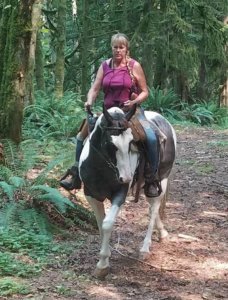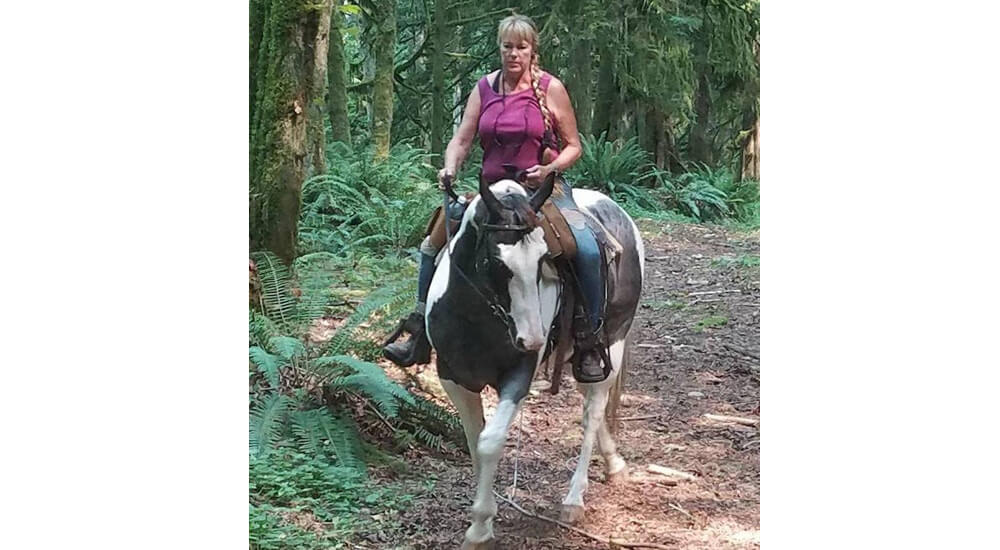Problems on the Trail Indicate a Hole in Basic Training
By Jill Holdal and Julie Lewis-Schot
Trail riding gives us the opportunity to take in the fresh air, sounds of nature, and beautiful scenery while we bond with our horses. But if you don’t feel you have control over your horse, it can be anything but relaxing and enjoyable.
What’s the first step in taking control?
It always comes back to a solid foundation. You can’t fix much on one trail ride. If you are having problems, it’s a sign there is a hole in your horse’s training. You need to work with him before you get out there, so you can give him direction when he needs it.
For example, if your horse jigs and your solution is to just pull back on your reins to slow him down it will likely only make the situation worse. He isn’t getting any direction really, he just feels that steady pressure and starts bracing against it. Then you will probably get even more jigging as he becomes frustrated and more worked-up. It’s like getting in a shouting match with someone. The argument gets louder, the energy rises, and not much gets communicated. The goal is to correct unwanted behavior with minimal force. That starts with softening exercises to give him clear direction.

I like to begin my trail rides with just a few minutes of softening exercises. I want the head and neck flexing side to side nicely, the hips and shoulders moving over with ease, and a smooth back-up. If your horse isn’t passing these pre-ride checks, he probably isn’t safe to ride on the trail. If you’re struggling to work on these things yourself, it’s safest to get help from a professional. Once you have this kind of communication with your horse, you’re equipped to get control on the trail.
What if I lose control on the trail?
The best thing you can do is to give your horse something to do to get his mind and body busy. For example, if he is prone to jigging, you should start working some exercises as soon as you feel his energy rise before the jigging starts. You might feel him stiffen up, brace on the bit, or raise his head up in preparation for the jig. Learning to recognize the warning signs will give you the edge.
Some trainers recommend circling around trees and things like that, which is great, but if you have dense vegetation on either side of the trail, that may not be possible. If there is enough width in the trail, I ask the excited horse to travel diagonally back and forth down the trail until he quiets down.
This kind of leg yield work is great for improving communication anyway, and because it is hard work for them, it can be an effective technique to redirect that energy. I like to throw some lateral neck flexion in there too. The more he must think about, the better. I don’t mind the forward energy, I use it to my advantage to push him into the diagonal work.
As soon as I feel him soften and relax, I will let him continue down the trail with a loose rein, but if he starts to get excited again, we start working hard again.
What if my horse spooks and wants to take off?
You need to act quickly and direct his body and feet where you want them until he is calm. Taking up the reins with a tight grip and no direction when a horse is spooked won’t help him settle down. You shouldn’t punish him for being scared, but you do need to guide him through it.
It’s also important for you and your horse to know the one-rein stop in case your horse decides to bolt. You can practice these at a walk down the trail and then ask for one step back to remind him to focus on you. It’s important not to let your emotions get the best of you. Keep things very black and white.
Don’t get angry when your horse acts up, it’s not productive. Stay focused on what you need to do to correct the behavior and be the leader your horse needs you to be when he struggles. If you don’t have the confidence to remain calm and focused while schooling your horse through his issues, it’s best to find a trainer you’re comfortable working with to assist you.
Jill Holdal resides in the scenic Walker Valley area of Mount Vernon, Washington. With over 40 years of experience, her techniques have proven successful for all breeds and disciplines. She offers foundation training, tune-ups, trail training (on real trails), and extreme horse makeovers. She specializes in making accurate training evaluations and tailoring effective schooling methods. This boutique style training means no assembly-line training and limited openings. She provides horses plenty of attention and consistency while staying at her property.
Holdal competes in barrel racing, ranch sorting, and cowboy races. She also enjoys trail riding, dressage, and is currently inspired by working equitation.
Find her on her “Jill’s Horse Training” Facebook page. Email [email protected] or call 360-422-8202.






